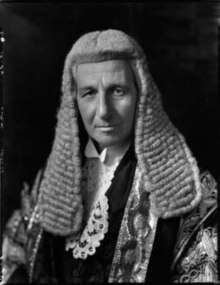Alexander Roche, Baron Roche
Alexander Adair Roche, Baron Roche PC (24 July 1871 – 22 December 1956)[1] was a British barrister and law lord.
The Lord Roche | |
|---|---|
 Lord Justice Roche in 1934 | |
| Lord of Appeal in Ordinary | |
| In office 1935–1938 | |
| Personal details | |
| Born | Alexander Adair Roche Ipswich, Suffolk |
| Died | Chadlington, Oxfordshire |
| Alma mater | Wadham College, Oxford |
Background
He was the second son of William Brock Roche and his wife Mary Fraser, daughter of William Fraser.[2] Roche was educated at Ipswich School and studied then at Wadham College, Oxford, where he graduated with a Bachelor of Arts in 1894 and a Master of Arts in 1913.[2] He was called to the bar by the Inner Temple in 1896 and went to the Northern Circuit.[3]
Career
Roche became a King's Counsel in 1912 and was elected a bencher in 1917.[4] Later in that year, he was appointed to the High Court of Justice (King's Bench Division), on which occasion he was created a Knight Bachelor.[4] He served as chairman of the Oxfordshire Quarter Sessions from 1932 and held the same post in the Central Agricultural Wages Board from 1940.[5]
In 1934, Roche was made a Lord Justice of Appeal and was sworn of the Privy Council.[5] On 14 October 1935 to fill a vacancy he was made a Lord of Appeal in Ordinary and created a life peerage as Baron Roche, of Chadlington in the County of Oxford.[6] Roche retired in 1938 and a year thereafter he became Treasurer of the Inner Temple.[7]
He subsequently chaired a Departmental Committee on justices' clerks which reported [8] in 1944 to the Home Secretary Herbert Morrison, recommending setting up Magistrates' Courts Committees and other reforms. This formed the basis of the Justices of the Peace Act 1949, introduced by Morrison's successor, James Chuter Ede.
Corporal Punishment
Speaking in January 1933, shortly after the passing of the Children and Young Persons Act of 1932 which had provoked debate about the use of corporal punishment, Roche argued that "the preservation of the power to whip, in proper cases, might be a useful thing". He went on to reflect that "looking back on their own boyhood, they could not fail to recognise that the right of their masters to correct them in that fashion was probably a useful thing in helping to mould their character"[9]
Family
On 22 March 1902, he married Elfreda Gabriel, third daughter of John Fenwick and had by her two sons and a daughter.[7]
References
- "Leigh Rayment - Peerage". Retrieved 17 January 2009.
- Walford, Edward (1919). The County Families of the United Kingdom. London: Spottiswoode, Ballantyne & Co. Ltd. p. 1148.
- Debrett, John (1922). Arthur G. M. Hesilrige (ed.). Debrett's House of Commons and Judicial Bench. London: Dean & Son Ltd. pp. 343–344.
- Whitaker's Peerage, Baronetage, Knightage and Companioage. J. Whitaker & Sons. 1923. p. 484.
- Who is Who 1951. London: Adam & Charles Black Ltd. 1951. p. 2442.
- "No. 34209". The London Gazette. 18 October 1935. p. 6541.
- "ThePeerage - Alexander Adair Roche, Baron Roche". Archived from the original on 22 November 2009. Retrieved 17 November 2009.
- Report, Cmnd 6507, HMSO, para 231
- "The Daily Mirror". "Keep the Right to Whip": A Judge Recalls Boyhood Days. 17 January 1933.
External links
- Hansard 1803–2005: contributions in Parliament by Alexander Roche, Baron Roche